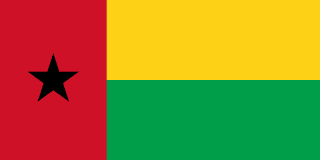Guinea-Bissau - Geography

Here, let us take a look at the Geography of Guinea-Bissau. This small country is swampy along its western coast and low-lying inland. Mother's mean age at first birth is (), whereas, the Maternal mortality ratio is 725 deaths/100,000 live births (2020 est.)
Geographical data of Guinea-Bissau
| Location | Western Africa, bordering the North Atlantic Ocean, between Guinea and Senegal |
|---|---|
| Geographic coordinates | 12 00 N, 15 00 W |
| Map references | Africa |
| Tarrain | mostly low-lying coastal plain with a deeply indented estuarine coastline rising to savanna in east; numerous off-shore islands including the Arquipelago Dos Bijagos consisting of 18 main islands and many small islets |
| Natural Resources | fish, timber, phosphates, bauxite, clay, granite, limestone, unexploited deposits of petroleum |
| Natural Hazards | hot, dry, dusty harmattan haze may reduce visibility during dry season; brush fires |
| Irrigated Land | 250 sq km (2012) |
| Major rivers (by length in km) | |
| Major aquifers | Senegalo-Mauritanian Basin |
| Land Boundaries | 762 km |
| Border Countries | Guinea 421 km; Senegal 341 km |
| Coastline | 350 km |
| Climate | tropical; generally hot and humid; monsoonal-type rainy season (June to November) with southwesterly winds; dry season (December to May) with northeasterly harmattan winds |
| Area | |
| Total Area | |
| Land Area | 28,120 sq km |
| Water Area | 8,005 sq km |
| comparative Area | slightly less than three times the size of Connecticut |
| Maritime Claims | |
| Territorial sea | 12 nm |
| Exclusive economic zone | 200 nm |
| Elevations | |
| Highest point | Dongol Ronde 277 m |
| Lowest point | Atlantic Ocean 0 m |
| Mean elevation | 70 m |
| Land Use | |
| Agricultural land | 30% (2022 est.) |
| Agricultural land: arable land | arable land: 14% (2022 est.) |
| Agricultural land: permanent crops | permanent crops: 8.9% (2022 est.) |
| Agricultural land: permanent pasture | permanent pasture: 7.1% (2022 est.) |
| Forest | 69.8% (2022 est.) |
| Other | 0.1% (2022 est.) |
Population Distribution
Approximately one-fifth of the population lives in the capital city of Bissau along the Atlantic coast; the remainder is distributed among the eight other, mainly rural, regions as shown in this population distribution map
People and Society
In Guinea-Bissau, the different Ethnic groups are such that we have: Balanta 30%, Fulani 30%, Manjaco 14%, Mandinga 13%, Papel 7%, unspecified smaller ethnic groups 6% (2015 est.)
| Population | |
|---|---|
| Pop growth rate | 2.54% (2024 est.) |
| Birth rate | 36 births/1,000 population (2024 est.) |
| Death rate | 7.2 deaths/1,000 population (2024 est.) |
| Health expenditure | 8.2% of GDP (2021) |
| Physicians Density | |
| Hospital bed Density | |
| Total fertility rate | 4.62 children born/woman (2024 est.) |
| Gross reproduction rate | 2.28 (2024 est.) |
| Contraceptive prevalence rate | 20.6% (2018/19) |
| Est married women (ages 15-49) | 56.7% (2023 est.) |
| Literacy | age 15 and over can read and write |
| Education expenditures | 2.7% of GDP (2020 est.) |
| Net Migration rate | -3.5 migrant(s)/1,000 population (2024 est.) |
| Nationality | Bissau-Guinean | Bissau-Guinean(s) |
| Languages | Portuguese-based Creole, Portuguese (official; largely used as a second or third language), Pular (a Fula language), Mandingo |
| Religions | Muslim 46.1%, folk religions 30.6%, Christian 18.9%, other or unaffiliated 4.4% (2020 est.) |
| Age Structure | |
| 0-14 years | 42.3% (male 453,513/female 448,514) |
| 15-64 years | 54.6% (male 561,868/female 602,280) |
| 65 years and over | 3.1% (2024 est.) (male 27,529/female 38,621) |
| Dependency Ratios | |
| Total dependency ratio | 76.6 |
| Youth dependency ratio | 71.6 |
| Elderly dependency ratio | 5 |
| Potential support ratio | 20.1 (2021 est.) |
| Median Age | |
| Total | 18.4 years (2024 est.) |
| Male | 17.8 years |
| Female | 18.9 years |
| Urbanization | |
| Urban population | 45.5% of total population (2023) |
| Rate of urbanization | 3.22% annual rate of change (2020-25 est.) |
| Major urban areas (Pop) | 664,000 BISSAU (capital) (2023). |
| Sex Ratio | |
| At birth | 1.03 male(s)/female |
| 0-14 years | 1.01 male(s)/female |
| 15-64 years | 0.93 male(s)/female |
| 65 years and over | 0.71 male(s)/female |
| Total population | 0.96 male(s)/female (2024 est.) |
| Infant Motality | |
| Total | 46.4 deaths/1,000 live births (2024 est.) |
| Male | 52 deaths/1,000 live births |
| Female | 40.6 deaths/1,000 live births |
| Life Expectancy at birth | |
| Total population | 64.5 years (2024 est.) |
| Male | 62.2 years |
| Female | 66.8 years |
| Drinking Water Sources | |
| Improved: urban | urban: 90.6% of population |
| Improved: rural | rural: 59.1% of population |
| Improved: total | total: 73.1% of population |
| Unimproved: urban | urban: 9.4% of population |
| Unimproved: rural | rural: 40.9% of population |
| Unimproved: total | total: 26.9% of population (2020 est.) |
| Sanitation facility acess | |
| Improved: urban | urban: 62.4% of population |
| Improved: rural | rural: 7.6% of population |
| Improved: total | total: 31.8% of population |
| Unimproved: urban | urban: 37.6% of population |
| Unimproved: rural | rural: 92.4% of population |
| Unimproved: total | total: 68.2% of population (2020 est.) |
| Alcohol consumption per capita | |
| Total | 3.21 liters of pure alcohol (2019 est.) |
| Beer | 0.41 liters of pure alcohol (2019 est.) |
| Wine | 0.98 liters of pure alcohol (2019 est.) |
| Spirits | 0.54 liters of pure alcohol (2019 est.) |
| Other alcohols | 1.28 liters of pure alcohol (2019 est.) |
| Tobacco use | |
| Total | 9% (2020 est.) |
| Male | 17% (2020 est.) |
| Female | 0.9% (2020 est.) |
| Child marriage | |
| Women married by age 15 | 8.1% |
| Women married by age 18 | 25.7% |
| Men married by age 18 | 2.2% (2019 est.) |
Demographic profile
All Important Facts about Guinea-Bissau
Want to know more about Guinea-Bissau? Check all different factbooks for Guinea-Bissau below.
-
 Guinea-Bissau Factbook
Guinea-Bissau Factbook
-
 The Economy of Guinea-Bissau
The Economy of Guinea-Bissau
-
 Learn about the Government of Guinea-Bissau
Learn about the Government of Guinea-Bissau
-
 Communication in Guinea-Bissau
Communication in Guinea-Bissau
-
 Popular Universities in Guinea-Bissau
Popular Universities in Guinea-Bissau
-
 Enerny in Guinea-Bissau
Enerny in Guinea-Bissau
-
 Transport in Guinea-Bissau
Transport in Guinea-Bissau
-
 The Geography and society of Guinea-Bissau
The Geography and society of Guinea-Bissau
-
 The Environment of Guinea-Bissau
The Environment of Guinea-Bissau
-
 Military and security in Guinea-Bissau
Military and security in Guinea-Bissau